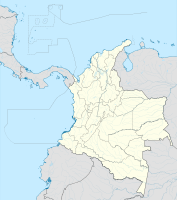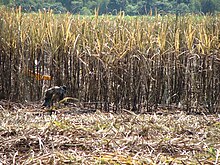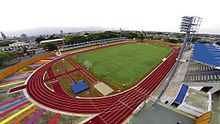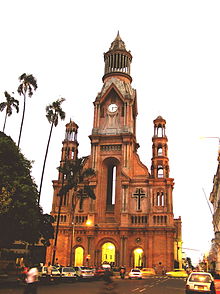Palmira (Colombia)
| Palmira | ||
|---|---|---|
|
Coordinates: 3 ° 35 ′ N , 76 ° 15 ′ W Palmira on the map of Colombia
|
||
|
Location of the municipality of Palmira in Valle del Cauca
|
||
| Basic data | ||
| Country | Colombia | |
| Department | Valle del Cauca | |
| City foundation | 1536 | |
| Residents | 312,507 (2019) | |
| - in the metropolitan area | 3,151,710 | |
| City insignia | ||
| Detailed data | ||
| surface | 1123 km 2 | |
| Population density | 278 inhabitants / km 2 | |
| height | 1824 m | |
| Time zone | UTC -5 | |
| City Presidency | Óscar Eduardo Escobar García (2020-2023) | |
| Website | ||
Palmira is a city and municipality ( municipio ) in the southern Colombian department of Valle del Cauca . Palmira is located on the eastern influence of the Río Cauca and is the second most important city in the region after Cali . The distance to Cali is 22 kilometers. Palmira is at the center of the Colombian sugar industry and is surrounded by large sugar cane fields . Palmira is named after its economic importance Capital Agrícola de Colombia (Agricultural Center of Colombia) and after its history Palmira Señorial ("The stately Palmira"), while Cali is nicknamed La Sultana del Valle ("The Sultana of the Cauca Valley"). Palmira is part of the unofficial metropolitan area of Calis, the metropolitan area of Cali .
geography
Palmira is located in the south of the Valle del Cauca. It borders the Municipios El Cerrito in the north, Rioblanco in Tolima in the east, Pradera and Candelaria in the south, and Santiago de Cali , Yumbo and Vijes in the west.
climate
The city of Palmira is determined by the tropical humid savannah climate. The temperature zones of the entire municipality vary from the hot climate on the banks of the Rio Cauca to cooler climates in the Páramo de las Hermosas in the Central Cordillera . The annual average temperature is 23 ° C and the mean altitude is 1001 meters above sea level. The watersheds are the river basins Rio Nima and Agua Clara .
Area and soil
The area of the municipality covers 1162 km², of which only 19.34 km² is built-up area. The agriculturally used area bordering the Río Cauca is approx. 1200 meters above sea level. Land use is mainly limited to the cultivation of sugar cane . Other important crops are coffee, rice, corn and tobacco. The National Road Institute (INVIAS) is currently working on the further expansion of the infrastructure, which is causing problems in particular on slopes at risk of erosion.
population
The municipality of Palmira has 312,507 inhabitants, of which 250,621 live in the urban part (cabecera municipal) of the municipality. The metropolitan region has 3,151,710 inhabitants (as of 2019).
fauna
The natural fauna was limited to a few natural retreats due to the intensive sugar cane cultivation and the advancing urbanization. Refuge areas are, for example, the Cuencas of the Amaime, Nima and El Cerrito rivers, where a high level of biodiversity has continued to exist . New World vultures, mainly black vultures, are particularly attracted to cattle.
history
Palmira was founded around 1680. General and President Francisco de Paula named the city in 1824 Villa de las Palmas or Nuestra Señora del Palmar , City of Palms, from which today's Palmira became. At that time Palmira had an estimated 3,000 inhabitants. In the 20th century large sugar cane plantations emerged, which led to a strong economic boom in the region. The Codazzi pioneer battalion created the Cali - Palmira road connection and the Panamericana intersection in the mid-1950s, which gave Palmira further growth impulses. The infrastructure is continuously being expanded, for example the Estadio Deportivo Cali .
Flag and city arms
The city coat of arms is based on the poem Canto a Palmira “Song to Palmira” written by Ricardo Nieto Hurtado in 1924 . It shows a sun to commemorate Simon Bolívar's proclamation of independence, palm trees as an allegory and a hammer that is struck with a heart on a blacksmith's anvil. The latter image alludes to the immigrants from other regions of Colombia who were working on the future of the city. The flag consists of the colors white for peace, green for the work of the palmiranos and yellow for the natural wealth and the fruits of the earth Palmira.
traffic
Road traffic
Companies such as Coodetrans Palmira, Palmirana de Transportes y Montebello, which thus exercise an oligopoly position , take care of local public transport . In addition, around 5,000 motorcycle taxis are privately employed. Several bus lines such as Expreso Palmira , Coodetrans Palmira and Expreso Florida are based in Palmira and offer national overland trips and important city connections. The northern access to Palmira via the Panamericana runs via Tuluá and Guadalajara de Buga , in the south via the province of Cauca and Candelaria , in the west via the Rio Cauca and Cali and in the east via Miranda, Florida and Pradera. In 1911 a car bridge was built over the Cañón del Amaime and an elevated road through the Páramo de las Hermosas , which connects Palmira with Chaparral and thus creates a car connection to Bogotá .
air traffic
One of the most important Colombian airports is the Aeropuerto Internacional Alfonso Bonilla Aragón (international airport symbol: CLO) in Palmaseca, about 15 minutes drive west of the city center of Palmira. The international airport is served by the companies Aires, Copa Airlines Colombia, Avianca, Satena and TAC and offers, in addition to national flights, international flight connections to Miami , Guayaquil , Madrid , Panama , Esmeraldas and Quito in Ecuador .
Shopping centers
The two major shopping centers and shopping miles of Palmira are Llanogrande Plaza “La Catorce” and Súper Marden El Bosque y Súper Marden la 47.
Sports
The second division Orsomarso SC, founded in 2012, is based in Palmira . The club plays its home games at the Estadio Francisco Rivera Escobar , which has a capacity of 9,000. The short-lived clubs Deportes Palmira (2009), Expreso Palmira (1999-2003), Palmira FC (1992-2001) and Univalle (1998) also had their headquarters in Palmira . There is also the women's soccer team Generaciones Palmiranas , which became champions in 2016 participated in the Copa Libertadores Femenina 2016 .
In the area of the municipality of Palmira there is also the Estadio Deportivo Cali , built in 2008 , which is the home of the Deportivo Cali club and is the largest stadium in Colombia with 53,347 seats. It is the only club-owned stadium in Colombia. It is located in the rural part of Palmira on the road between Cali and Palmira near the airport in Palmaseca.
religion
The diocese of Palmira has its seat in Palmira .
Security situation
According to a study by the organization El Consejo Ciudadano para la Seguridad Pública y la Justicia Penal ( German "Citizens' Council for Public Security and Criminal Law" ), Palmira is the second most dangerous city in Colombia and ranked 37th worldwide in 2017. A total of 144 murder cases in one Population of 308,669 corresponds to a murder rate of 46.65 per 100,000 inhabitants.
Universities and colleges
The following universities and colleges are located in Palmira:
- Universidad Nacional de Colombia (Unal)
- Universidad del Valle (Univalle)
- Universidad Santiago de Cali (USC)
- Universidad Antonio Nariño
- Fundación Universitaria San Martín
- Universidad Pontificia Bolivariana
- Fundación Universitaria Luis Amigó
- Universidad Abierta ya Distancia (UNAD)
- Corporación Universitaria Remington
Attractions
- Museo de La Caña, sugar cane museum
- Edificio Antigua Alcaldía, old town hall (Monumento Nacional)
- Estación del Ferrocarril, railway station (Monumento Nacional)
- Catedral Nuestra Señora del Rosario del Palmar , Cathedral of the Diocese of Palmira (Monumento Nacional)
- Edifico de Agronomía en la Universidad Nacional, Agricultural School of the National University (Monumento Nacional)
- Hacienda La Rita, Ingenio Manuelita sugar cane mill (Monumento Nacional), birthplace of the writer Jorge Isaacs
- Hacienda El Oriente
- Museo Nacional del Transporte, National Transport Museum between Palmira-Cali
- Estadio Deportivo Cali, stadium of Deportivo Cali, between Palmira-Cali
- Parque del Azúcar amusement park
- Iglesia de Nuestra Señora del Carmen
- Parque de Bolívar
- Centro Internacional de Agricultura Tropical , international agricultural research center
- ICA, National Agricultural Research Center
Sons and daughters
- Luis Adriano Piedrahíta Sandoval (* 1946), Roman Catholic clergyman, Bishop of Apartadó (2007–2014) and Santa Marta (2014–)
- Juan Carlos Ramírez Abadía (born 1963), criminal
- Carlos Llamosa (born 1969), American football player
- Adriana Bottina (* 1977), actress and singer
- Ingrid Vidal (* 1991), soccer player
- John Stiven Mendoza (* 1992), football player
- Kevin Quintero (* 1998), track cyclist
literature
- Álvaro Raffo Rivera: De Llano Grande a Palmira. Cali: Imprenta Departamental del Valle, 1992
Web links
- Palmira Municipality website (Spanish)
Notes and individual references
- ↑ ESTIMACIONES DE POBLACIÓN 1985 - 2005 Y PROYECCIONES DE POBLACIÓN 2005 - 2020 TOTAL DEPARTAMENTAL POR ÁREA. (Excel; 1.72 MB) DANE, May 11, 2011, accessed on May 2, 2019 (Spanish, extrapolation of the population of Colombia).
- ↑ The 50 most dangerous cities in the world travelbook.de, accessed on March 29, 2018
- ↑ it. National monument
- ↑ http://www.palmira.gov.co/palmira/documentos/historia.pdf ( page no longer available , search in web archives ) Info: The link was automatically marked as defective. Please check the link according to the instructions and then remove this notice.









